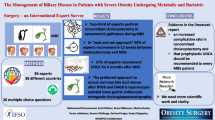Background
The normal stomach is virtually sterile but the effect of Roux-en-Y gastric bypass (RYGBP) on bacterial flora in the used (very small proximal pouch) and unused (large bypassed) gastric chambers is not known. In a prospective study, this variable was documented.
Methods
Bariatric subjects (n = 37) were submitted to endoscopic examination of both gastric reservoirs via FUJINON enteroscope model EN-450P5, 7.3 ± 1.4 years after RYGBP. Age was 42.4 ± 9.9 years (70.2% females), preoperative BMI was 53.5 ± 10.6, and current BMI was 32.6 ± 7.8 kg/m2. Methods included quantitative culture of gastric secretion along with gastric pH and lactulose/hydrogen breath test.
Results
None of the subjects displayed diarrhea, malabsorption or other complaints suggestive of GI bacterial overgrowth. Elevated counts of bacteria and fungi were identified in both chambers, with predominance of aerobes and anaerobes, but not molds and yeasts, in the proximal stomach. Gram-positive cocci, bacilli and coccobacilli represented the majority of the isolates. Gastric pH was neutral (pH 7.0 ± 0.2) in the proximal pouch, whereas the distal chamber mostly but not always conserved the expected acidity (pH 3.3 ± 2.2, P < 0.001). The breath test for bacterial overgrowth was positive in 40.5% of the population.
Conclusions
1) Frequent colonization of both gastric chambers was detected; 2) Aerobes, anaerobes and fungi were represented in both situations; 3) Gastric pH as well as bacterial count was higher in the functioning proximal stomach; 4) Breath test was positive in 40.5% of the subjects; 5) Clinical manifestation such as diarrhea, malabsorption or pneumonia were not demonstrated; 6) Further histologic and microbiologic studies of both the stomach and the small bowel are recommended.
Similar content being viewed by others
References
Bray GA, Benfield JR. Intestinal bypass for obesity a summary and perspective. Am J Clin Nutr 1977; 30: 121–7.
Anonymous: Intestinal bypass operation as a treatment for obesity. Ann Intern Med 1976; 85: 97–109.
Passaro E Jr, Drenick E, Wilsion SE. Bypass enteritis. A new complication of jejunoileal bypass for obesity. Am J Surg 1976; 131: 169–74.
Greco M, De Micheli E, Konardo A. Multifactorial hepatopathy in a patient with biliopancreatic diversion. Ann Ital Med Int 2003; 18: 99–103.
Michielson D, Van Hee R, Hendrickx L. Complications of biliopancreatic diversion surgery as proposed by Scopinaro in the treatment of morbid obesity. Obes Surg 1996; 6: 416–20.
Martinsen TC, Bergh K, Waldum HL. Gastric juice: a barrier against infectious diseases. Basic Clin Pharmacol Toxicol 2005; 96: 94–102.
O’May GA, Reynolds N, Macfarlane GT. Effect of pH on an in vitro model of gastric microbiota in enteral nutrition patients. Appl Environ Microbiol 2005; 71: 4777–83.
Sakai P, Kuga R, Safatle-Ribeiro A et al. Is it feasible to reach the bypassed stomach after Roux-en-Y gastric bypass for morbid obesity? The use of double-balloon enteroscope. Endoscopy 2005; 37: 566–9.
Ishida RK, Faintuch J, Sakai P et al. Microbial counts of the stomach after Roux-en-Y gastric bypass (RYGBP) for morbid obesity. Obes Surg 2006; 16: 430 (abst P14).
Mandel GL, Bennett JE, Dolin R, eds. Principles and Practice of Infectious Disease, 4th edn. Philadelphia: Churchill Livingstone 1995: 2204–9.
Misliver PB, Beuchat LR, Cousin MA. Yeasts and molds. In: Vanderzant C, Splittstoesser DF, eds. Compendium of the Microbiological Examination of Foods, 3a edn. Washington: American Public Health Association 1992: 239–49.
Romagnuolo J, Schiller D, Bailey R. Using breath tests wisely in a gastroenterology practice: an evidence-based review of indications and pitfalls in interpretation. Am J Gastroenterol 2002; 97: 1113–26.
Feldman C, Kassel M, Cantrell J et al. The presence and sequence of endotracheal tube colonization in patients undergoing mechanical ventilation. Eur Respir J 1999; 13: 546–51.
Husebye E. The pathogenesis of gastrointestinal bacterial overgrowth. Chemotherapy 2005; 51 (Suppl 1): 1–22.
Pereira SP, Gainsborough N, Dowling RH. Druginduced hypochlorhydria causes high duodenal bacterial counts in the elderly. Alim Pharmacol Ther 1998; 12: 99–104.
Miller AD, Smith KM. Medication and nutrient administration considerations after bariatric surgery. Am J Health Syst Pharm 2006; 63: 1852–7.
Mason EE, Munns JR, Kealey GP et al. Effect of gastric bypass on gastric secretion. Am J Surg 1976; 131: 162–8.
Ley RE, Backhed F, Turnbaugh P et al. Obesity alters gut microbial ecology. Proc Natl Acad Sci USA. 2005; 102: 11070–5.
Harter RL, Kelly WB, Kramer MG et al. A comparison of the volume and pH of gastric contents of obese and lean surgical patients. Anesth Analg 1998; 86: 147–52.
Riordan SM, McIver CJ, Wakefiekd D et al. Serum immunoglobulin and soluble IL-2 receptor levels in small intestinal overgrowth with indigenous gut flora. Dig Dis Sci 1999; 44: 939–44.
Yang CS, Lee WJ, Wang HH et al. Spectrum of endoscopic findings and therapy in patients with upper gastrointestinal symptoms after laparoscopic bariatric surgery. Obes Surg 2006; 16: 1232–7.
MacGregor AM, Pickens NE, Thoburn EK. Perforated peptic ulcer following gastric bypass for obesity. Am Surg 1999; 65: 222–5.
Richter JE. Duodenogastric reflux-induced (alkaline) esophagitis. Curr Treat Options Gastroenterol 2004; 7: 53–8.
Friis-Hansen L, Rieneck K, Nilsson HO et al. Gastric inflammation, metaplasia, and tumor development in gastrin-deficient mice. Gastroenterology 2006; 131: 246–58.
Author information
Authors and Affiliations
Corresponding author
Rights and permissions
About this article
Cite this article
Ishida, R.K., Faintuch, J., Paula, A.M.R. et al. Microbial Flora of the Stomach after Gastric Bypass for Morbid Obesity. OBES SURG 17, 752–758 (2007). https://doi.org/10.1007/s11695-007-9139-6
Received:
Accepted:
Published:
Issue Date:
DOI: https://doi.org/10.1007/s11695-007-9139-6




